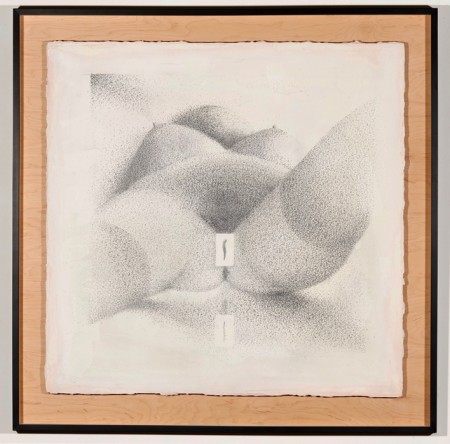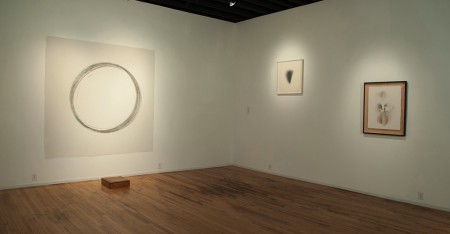How are we to understand the intentions of a conceptual artist like Tom Marioni when he mounts an exhibition of objects using traditional mediums like fresco, drawing and bronze sculpture? It’s true that with conceptual art the medium is dictated by the idea (as Marioni has said with typical humor, a conceptual artist is “free to work in any medium except painting”). But this exhibition’s title, Dry Fresco, Drawings and Bronze, draws attention to these classical and decidedly non-conceptual mediums. And many of the drawings are female nudes. So it’s fair to posit that Marioni is making a point in his usual intelligently wry manner. To understand what that point might be we need to consider the work in this exhibit (obviously), but also a bit of Marioni’s large body of past work.
Dry Fresco, Drawings and Bronze consists mostly of just that: new graphite drawings of female nudes on plaster (ie dry fresco), his drum brush drawings on plaster and sand paper, bronze sculptures made between 1990 and 1999, and his circle drawings (in honor of the 100th anniversary of cubism, Marioni dubbed 2007 the “year of the circle”, and made only circle drawings that year).

The figurative dry fresco drawings are the most recent pieces, never shown before to my knowledge, and also his biggest departure. Marioni’s work has always related to the body, as in his Out of Body Free Hand Circle On Prepared Wall, Cincinnati B, a performative piece in which his arm is used as a sort of compass to draw a circle, over and over. But never until now has his work been of the body. Landscape with Finger Line and Life for M.D. (perhaps a nod to Marcel Duchamp and his female alter ego, Rrose Sélavy) are both drawings of a nude female, the former from the same vantage point as Courbet’s Origin of Life, with the woman’s breasts and faint outline of a head resembling hills that, along with Marioni’s title, invoke a pastoral landscape.
The relationship of Marioni’s past work to the body is a complex one that implicates pretty much the entire history of conceptual art. The most convenient place to start is Joseph Beuys’ concept of social sculpture as a way for an artist to use actions and objects to, in a nutshell, improve society. For Beuys, everybody is an artist – something as mundane as peeling a potato “can be a work of art as long as it is a conscious act.” Marioni certainly had Beuys in mind when he created his signature work, The Act of Drinking Beer with Friends is the Highest Form of Art, perhaps poking a bit of fun at Beuy’s German severity and seriousness. In the piece, Marioni simply drank beer with friends in an exhibition space, and left the cans as proof of the act. The act, and therefore the body, was the medium. In this way, Marioni’s art is grounded in sculpture and the body, and it is why Marioni calls himself a sculptor.

So why the figurative drawings? It could be a sort of reminder of the importance of the body to Marioni’s work in particular, and to conceptual art in general. As if to say the body is a crucial part of art history from cave paintings, through the Renaissance, up to conceptual art, although in subtler ways, and here’s a not so subtle reminder of that fact. This is part of it, but I think the answer may be a bit more complicated. As we know, good art contains multitudes. The literature accompanying Marioni’s exhibition mentions that the nude drawings relate to San Francisco’s figurative movement (presumably, the Bay Area Figurative Movement). This movement adopted gestural figuration and representation as a reaction to the dominance of abstract expressionism. Notice the parallels to conceptual art of the 1960s and 1970s, of which Marioni was a part, which eschewed the machoism and religiosity of the abex painters.
The Bay Area Figurative Movement was also, like West coast conceptual art, purely a West coast phenomenon. As Thomas McEvilley has pointed out, even though the New York conceptualists scorned the abstract expressionist’s “cult of aesthetic feeling”, they still had their roots in “the awe of the sublime”. California, on the other hand, had beat poets, Steinbeck, Henry Miller in Big Sur, Asian thought and art, Hollywood, and comedy. These sources for West coast conceptual artists like Marioni and Baldessari are the same as for Bay Area figurative painters like Diebenkorn and Thiebaud. In other words, Marioni’s inclusion of figurative drawings in this exhibit, and its explicit reference to the Bay Area Figurative Movement, is a nod to the parallels of these movements that together make what Marioni considers a uniquely West coast art.
The inclusion of the different mediums is in keeping with Marioni’s desire to eradicate (or at least question) the distinctions not just between mediums like sculpture and drawing, but between visual art, music and performance. Marioni is that unique artist who can pull together from these numerous disciplines and sources and still remain truly original. Dry Fresco, Drawings and Bronze is a testament to that talent. It is an exhibit full of ideas (of which only a few are modestly expounded upon here). But it also contains formally interesting objects, even though objecthood is something conceptual artists typically care little about. But as we know, Marioni is not your typical artist.
Matthew Metzger is an artist and designer. His website is www.metzgerfinearts.com